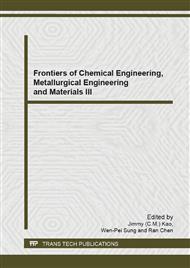[1]
M.H.J. Bollen, Understanding Power Quality Problems —Voltage Sags and Interruptions, IEEE Press, New York, (2000).
Google Scholar
[2]
IEEE Recommend Practice Evaluating Electric Power System Compatibility with Electronic Process Equipment, IEEE Standard 1346-1998, (1998).
Google Scholar
[3]
Short Tom A., Mansoor Arshad, Sunderman Wes, Sundaram Ashok, Site variation and prediction of power quality, IEEE Trans. Power Del., 18(4): 1369-1375, Oct. (2003).
DOI: 10.1109/tpwrd.2003.817755
Google Scholar
[4]
Heine Pirjo, Lehtonen Matti, Oikarinen Arvo, Overvoltage protection, faults and voltage sags, Proceedings of Int. Conf. Harmonics Qual. Power, Lake Placid, NY, United States, Sep 12-15 2004. pp.100-105.
DOI: 10.1109/ichqp.2004.1409336
Google Scholar
[5]
Chan-Nan Lu and Cheng-Chieh Shen, Estimation of sensitive equipment disruptions due to voltage sags, IEEE Trans. Power Del., 22(2): 1132-1137, (2007).
DOI: 10.1109/tpwrd.2007.893433
Google Scholar
[6]
Xianyong Xiao, Xuna Liu and Honggeng Yang, Stochastic estimation trip frequency of sensitive equipment due to voltage sag, presented at 2008 IEEE ASIA PACIFIC CONFERENCE ON CIRCUITS AND SYSTEMS-APCCAS 2008, paper ID 7051, November 30-December 3, 2008, Macao, China.
DOI: 10.1109/apccas.2008.4746035
Google Scholar
[7]
Milanovic Jovica V., Gupta Chandra P., Probabilistic assessment of financial losses due to interruptions and voltage sags - Part I: The methodology, IEEE Trans. Power Del., 21(2): 918-924, Apr. (2006).
DOI: 10.1109/tpwrd.2006.870988
Google Scholar
[8]
Jhan Yhee Chan, Milanovic Jovica V., Methodology for assessment of financial losses due to voltage sags and short interruptions, Int. Conf. Electr. Power Qual. Util., EPQU, Barcelona, Spain, Oct 9-11 2007, p.4424119.
DOI: 10.1109/epqu.2007.4424119
Google Scholar
[9]
Juan A. Martinez. Voltage sag stochastic prediction using an Electromagnetic Transients Program, IEEE Trans. Power Del., 2004, 19(4): 1975-(1982).
DOI: 10.1109/tpwrd.2004.829125
Google Scholar
[10]
Arup Kumar Goswami, Chandra Prakash Gupta, Girish Kumar Singh. Stochastic estimation of balanced and unbalanced voltage sags in Large System, presented at First International Conference on Emerging Trends in Engineering and Technology, 16-18 July 2008, Page(s): 443 - 446.
DOI: 10.1109/icetet.2008.42
Google Scholar
[11]
M.H.J. Bollen, Method of critical distances for stochastic assessment of voltage sags, IEE Proc Gener. Transm. Distrib., 1998, 145(1): 70-76.
DOI: 10.1049/ip-gtd:19981739
Google Scholar
[12]
C. H. Park, G, Jang and R. J. Thomas, The influence of generator scheduling and time-varying fault rates on voltage sag prediction, IEEE Trans. Power Del., 2008, 23(2): 1243-1250.
DOI: 10.1109/tpwrd.2008.915836
Google Scholar
[13]
Chen L., Matoba S., Inabe H., Okabe T., Surrogate constraint method for optimal power flow, IEEE Trans. Power Syst., 1998, 13(3): 1084-1089.
DOI: 10.1109/59.709103
Google Scholar
[14]
Bollen M.H.J., Effects of adverse weather and aging on power system reliability, IEEE Trans Ind Appl, 2001, 37(2): 452-457.
DOI: 10.1109/28.913708
Google Scholar
[15]
Moon J F, Park C H, Kim J C, et al, Reliability evaluation of distribution system through the analysis of time-varying failure rate, IEEE Power Eng. Soc. Gen. Meet., Denver, CO, United States, Jun 6-10 2004, pp.668-673.
Google Scholar


